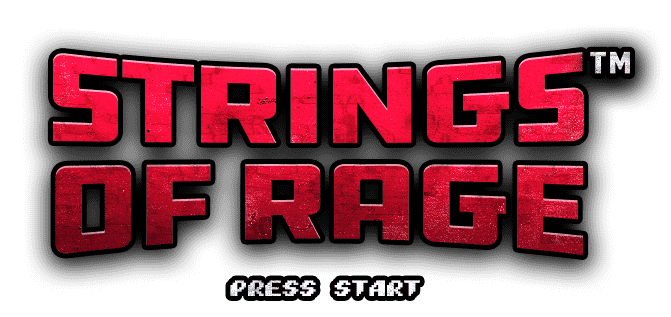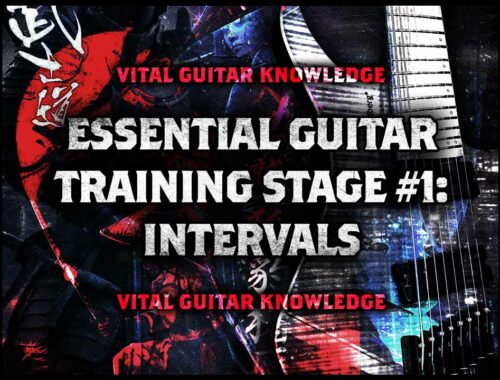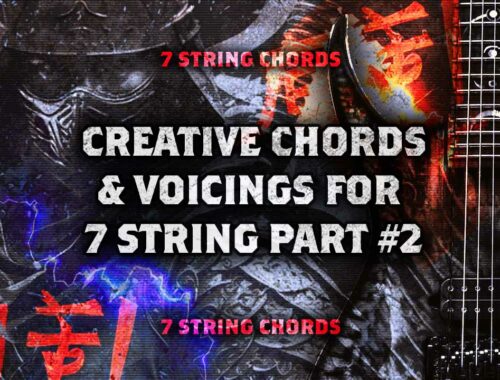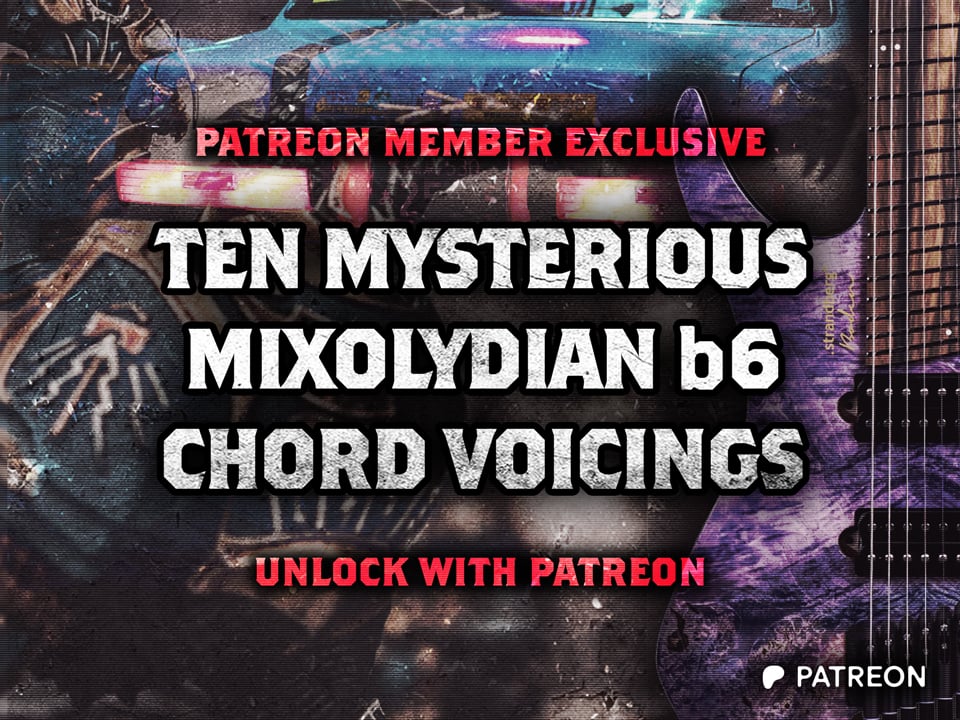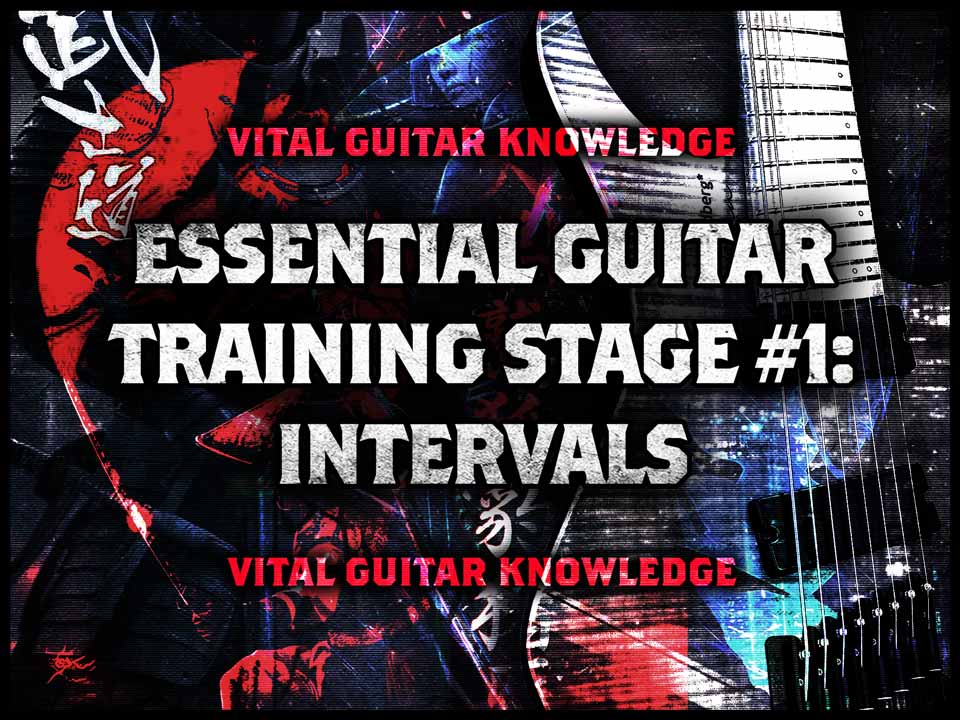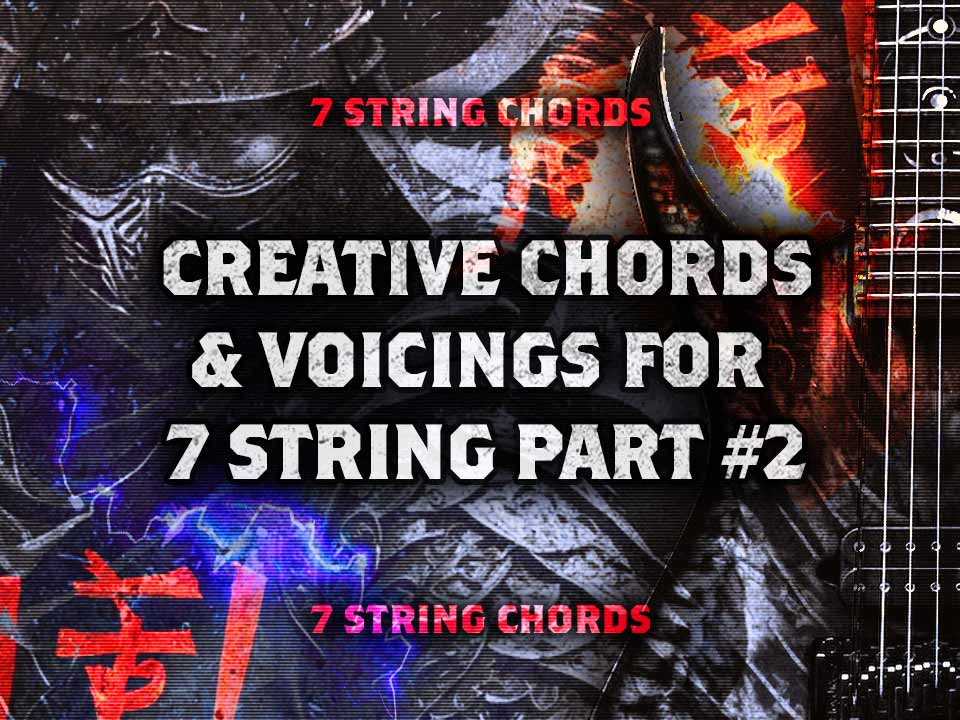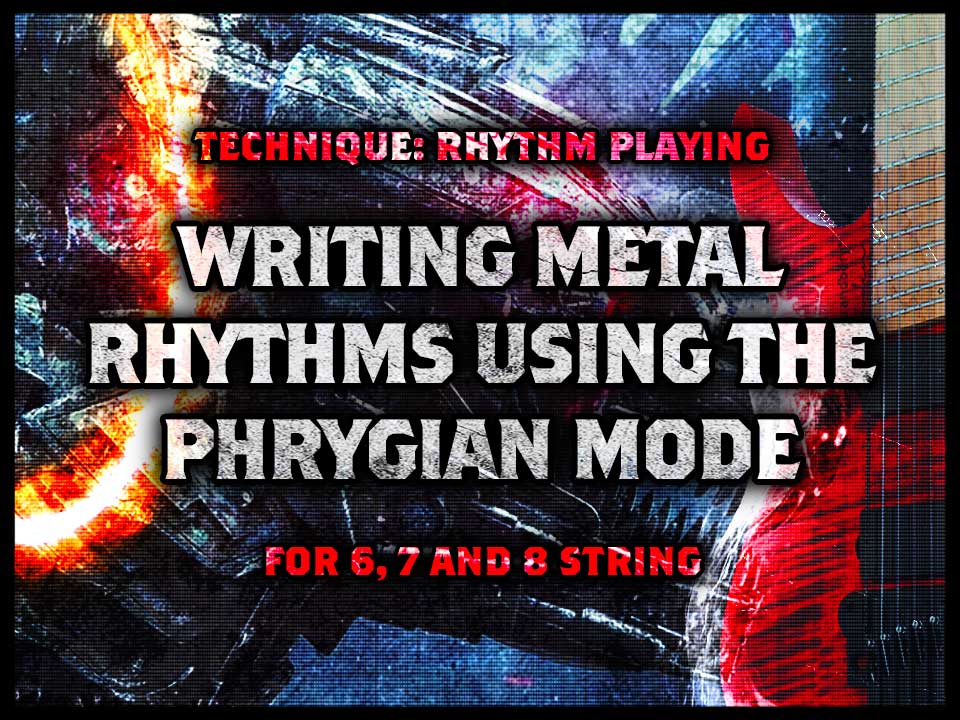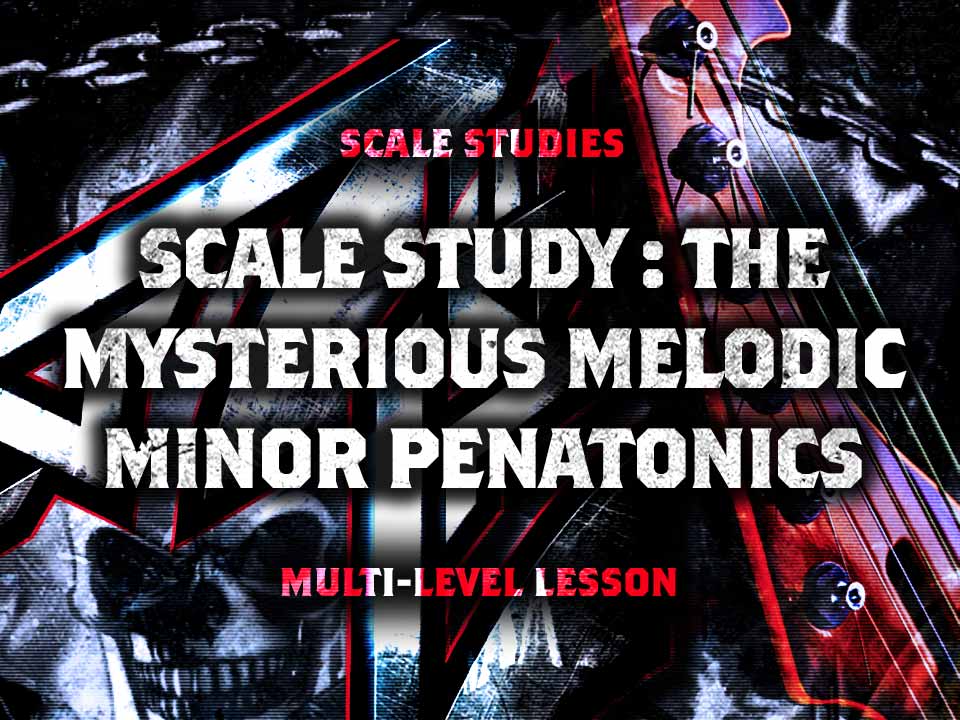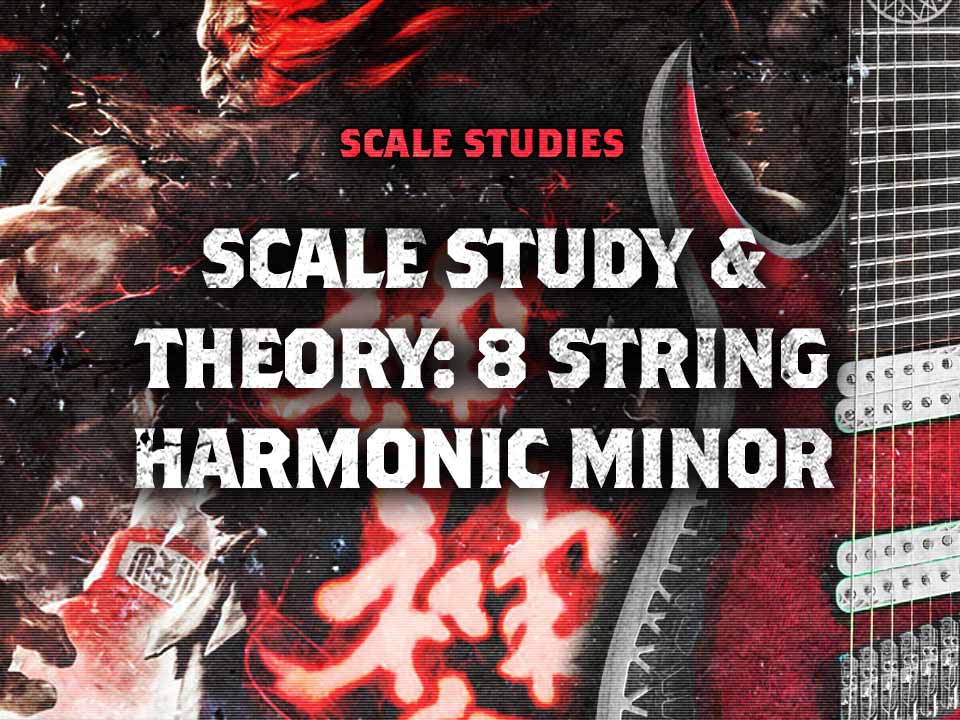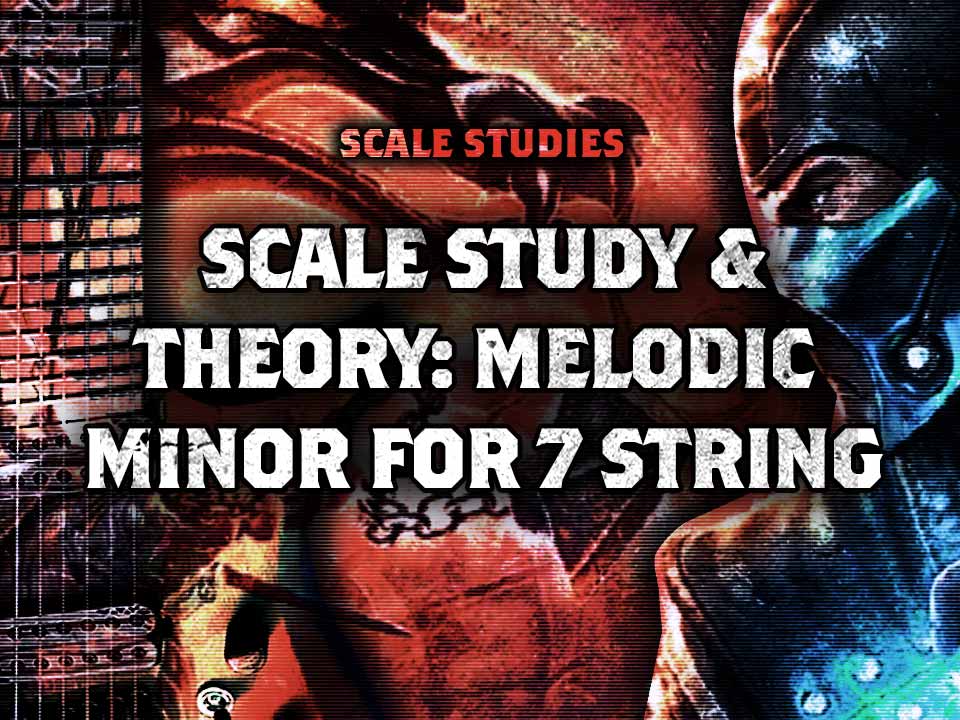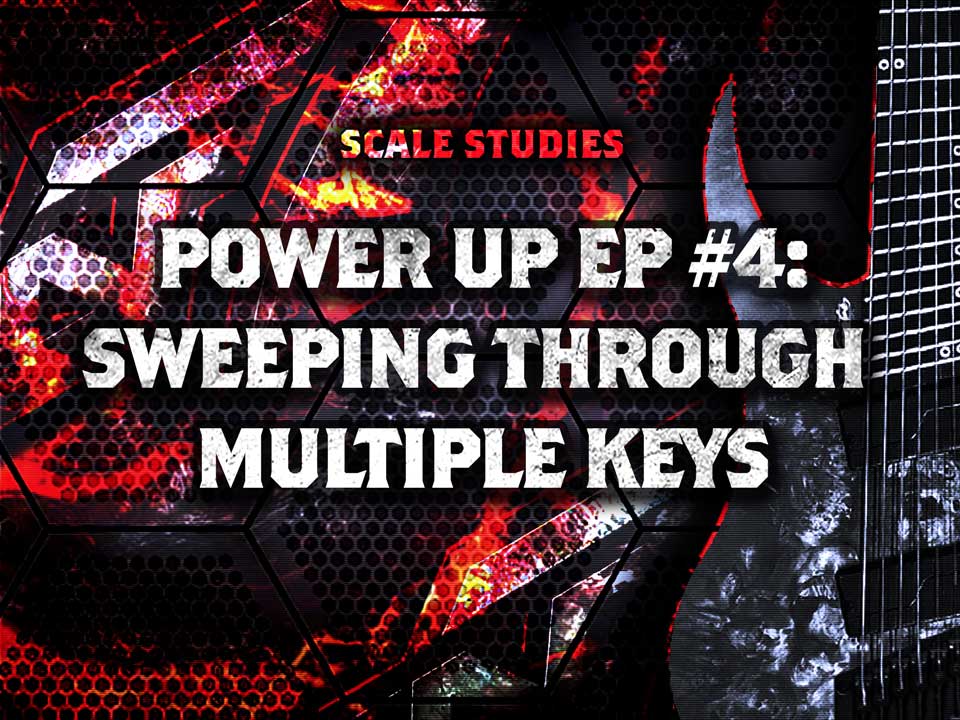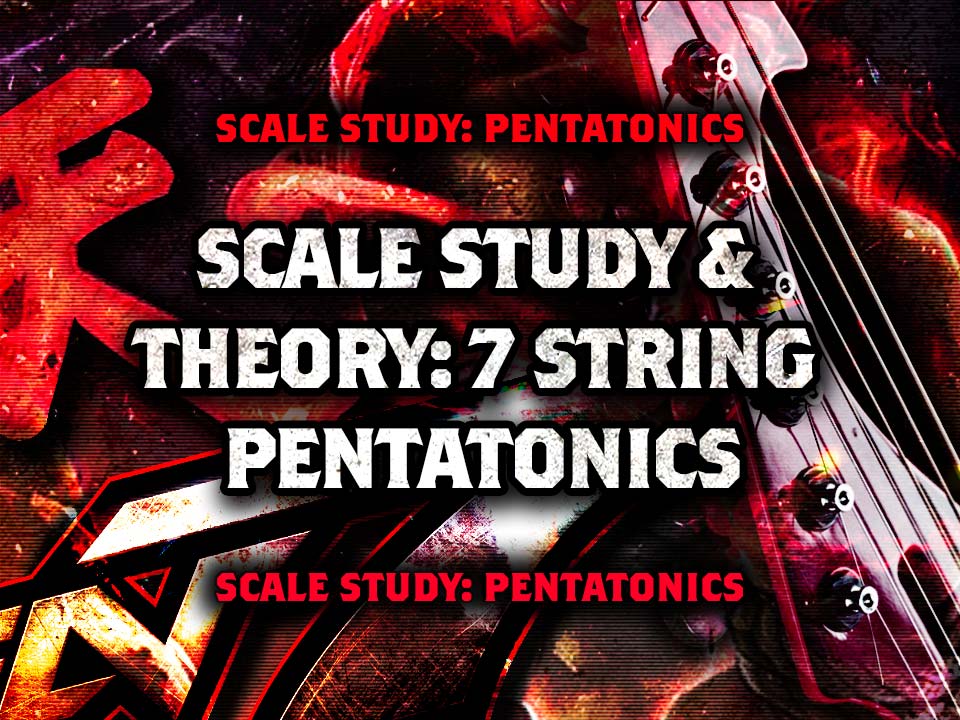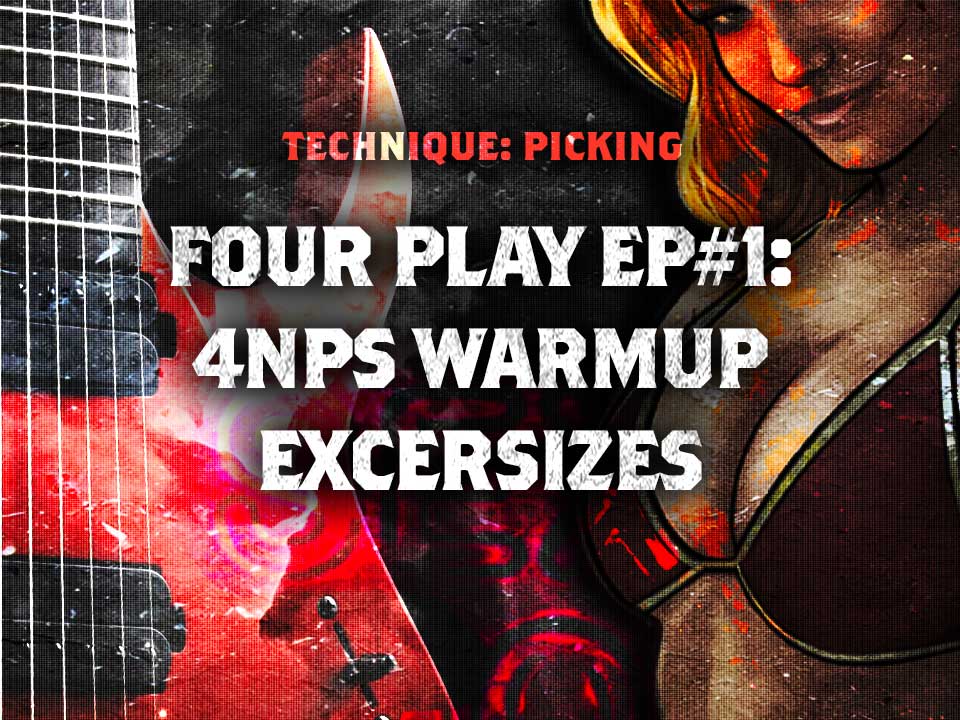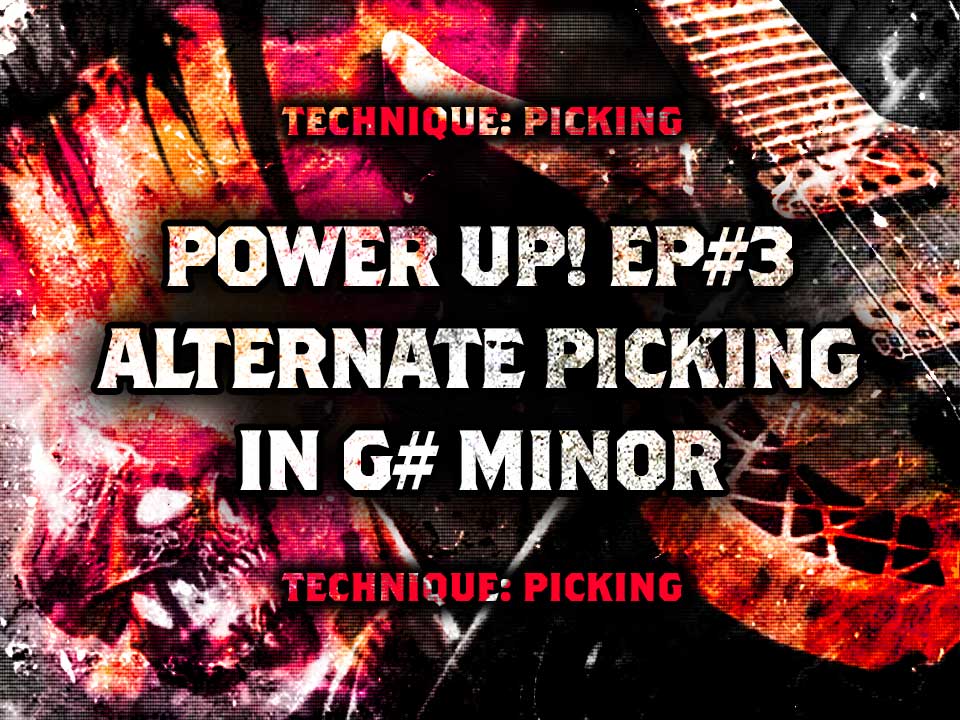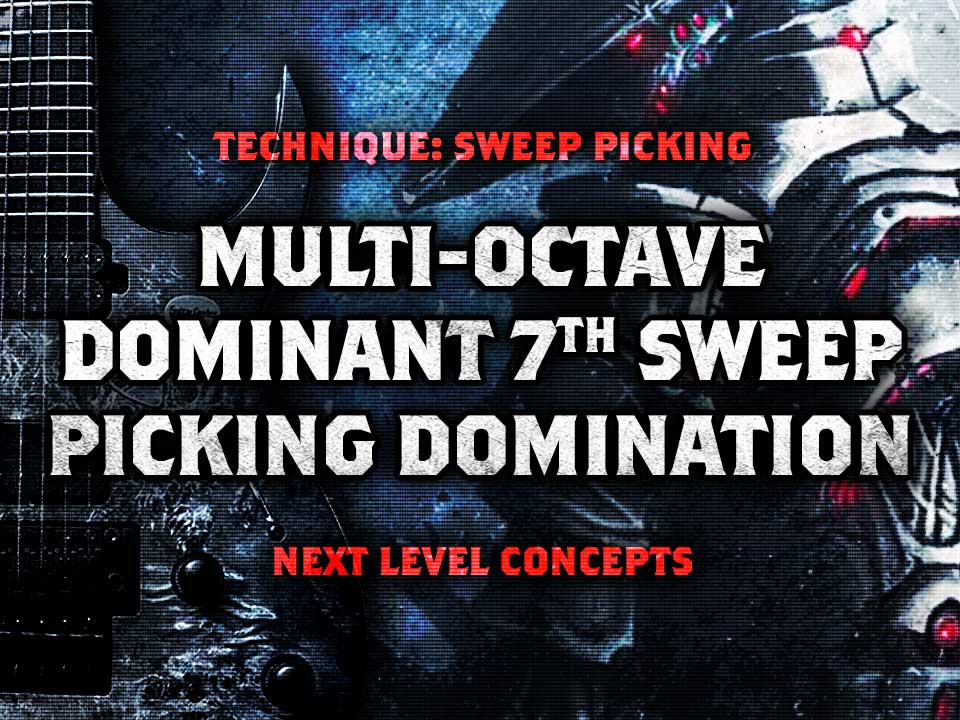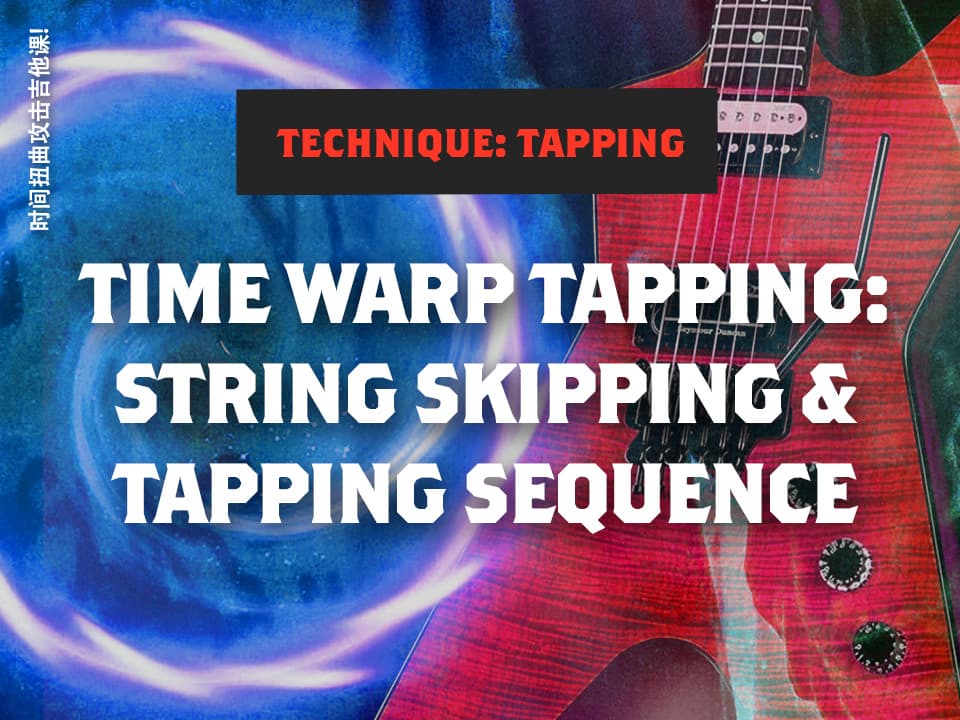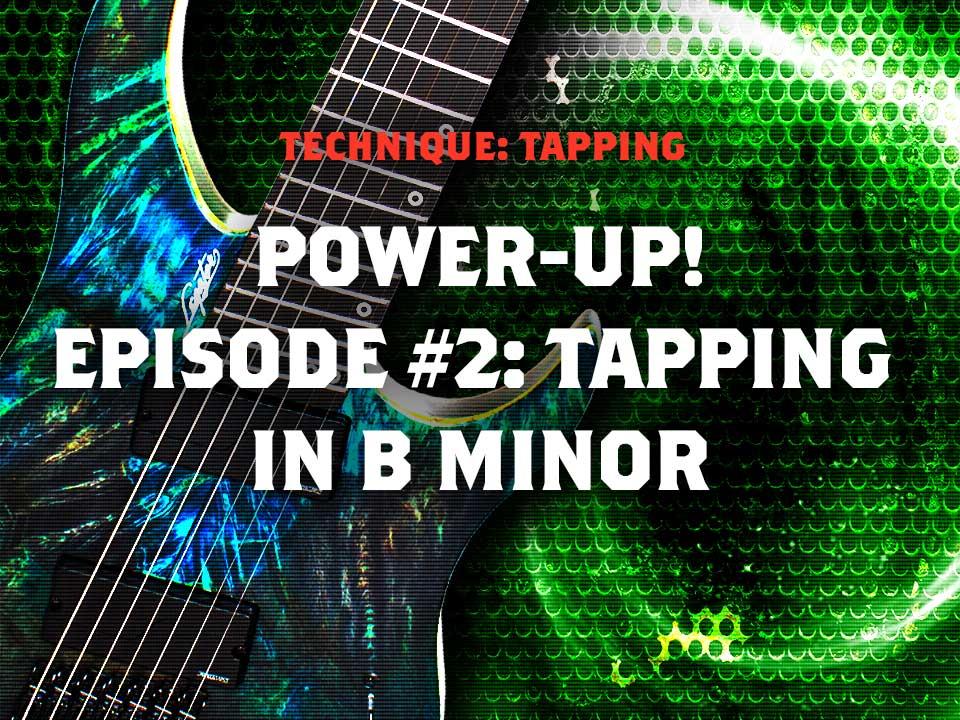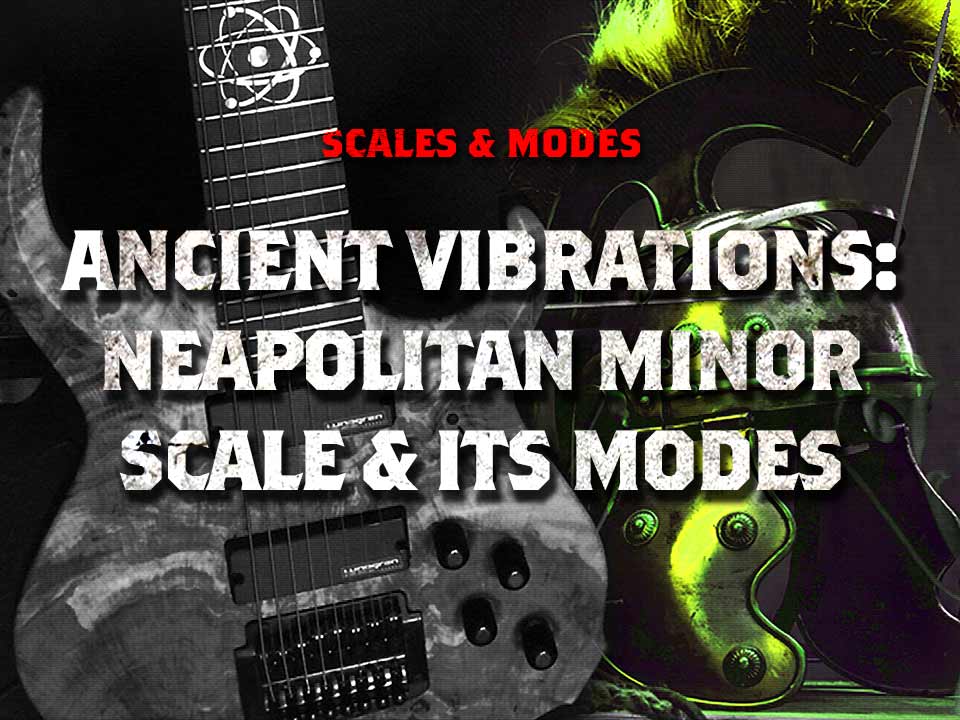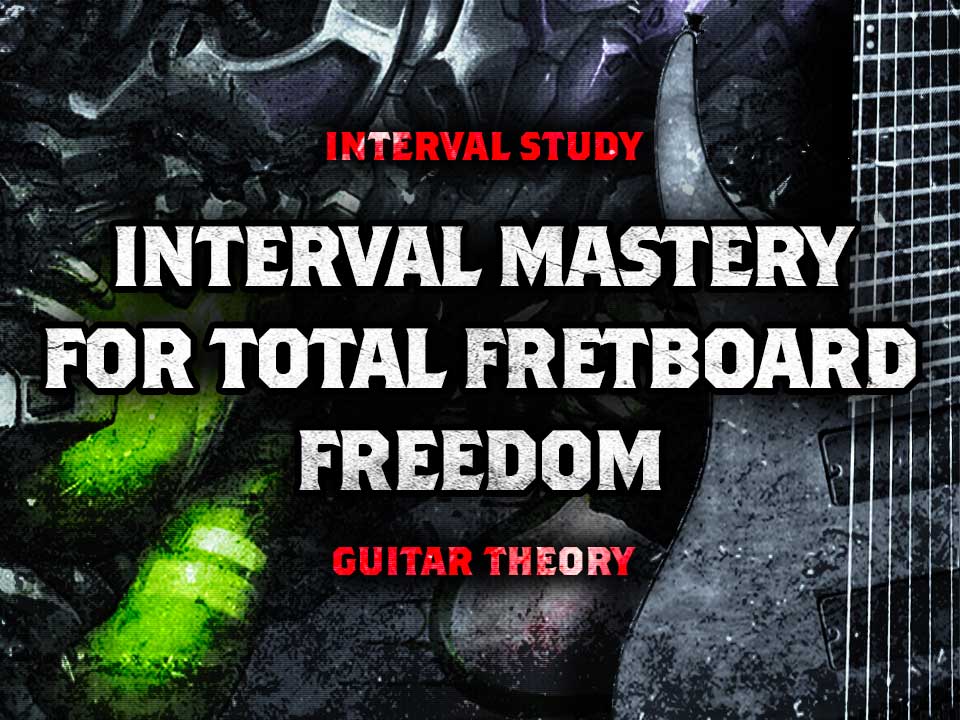Welcome to Strings of Rage™ essential training. This is a complete & ongoing series specifically about fretboard visualisation. We are going back to basics & looking at absolutely fundamental required knowledge. Too many players do not have a solid understanding of what they are doing on the neck. This series will change that.
We’re going to show you how to break out of restrictive freeboard visualisation systems such as CAGED and 3nps. We want to prevent auto-piloting through large shapes and promote a truly concrete understanding of the guitar neck. We’ll do this using a highly adaptive and limitless intervallic thinking method which is used by many of our inspirations such as Per Nillson, Jack Gardiner, Tom Quayle and LoG to name a few.
HEADS UP : This is a theory heavy lesson but grab your guitar because we’re going to be applying this knowledge on the guitar towards the end. This lesson will require patience, brutal self honesty and the desire to improve.
In this first episode we’re going to have a brutally honest look at our understanding of intervals for guitar. All music consists of intervals so a complete mastery of intervals is essential. We’ve looked at intervals and interval functions in-depth before in this lesson and we’d recommend checking that out after this lesson too. We’ll look at how to apply intervallic thinking over the neck in order to see the neck as a whole. Thus breaking away from limiting alternative systems. If you can truly master the intervals for guitar, you’ll be able to do anything. Let’s do this!
Invest Your Time: 19 minutes
Continue ReadingWelcome to the second instalment of 7 String Guitar Chords! Hopefully you’ve already seen part one by Joe. His 7 string chord lesson used ‘Drop A’ tuning. However in this 7 string chord lesson we’re just going to be using standard 7 string tuning which is B E A D G B E.
If you don’t have a 7 string guitar, don’t worry. All of these chords sound great on 6 string too. You can just leave out the low B string if you don’t have one. We’ll clearly show you the interval construction of each chord so that if you really know your intervals you’ll be able to re-voice the chord for 6 string.
A lot of these 7 string guitar chords will use open strings. Open strings facilitate a big sound and in some cases let you use all 7 strings. The low B string definitely gives a chord more balls and helps to chunk it up for a fatter sound. Let’s get into it!
eBook for This Lesson: Patron Exclusive
Strings of Rage™ syndicate member patrons get exclusive axe-cess to the ebook for this lesson. Print copies can also be requested.
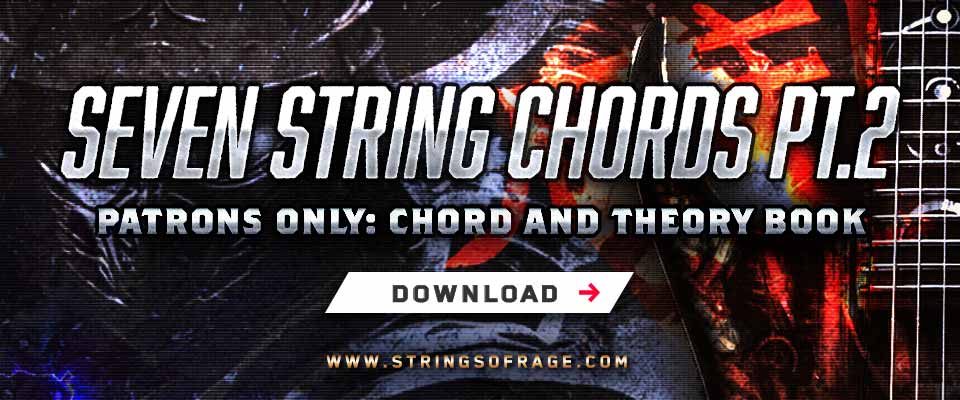
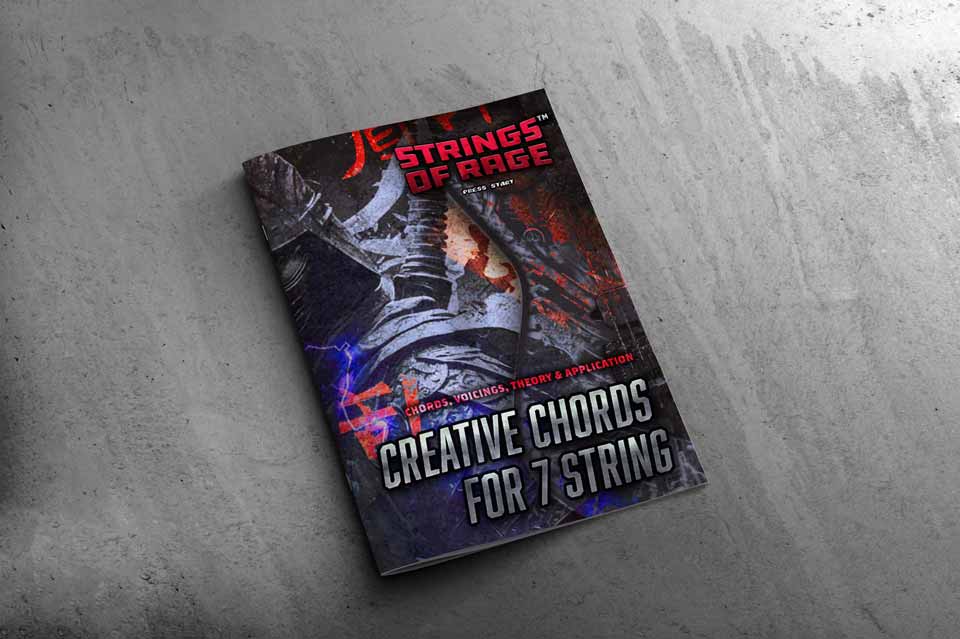
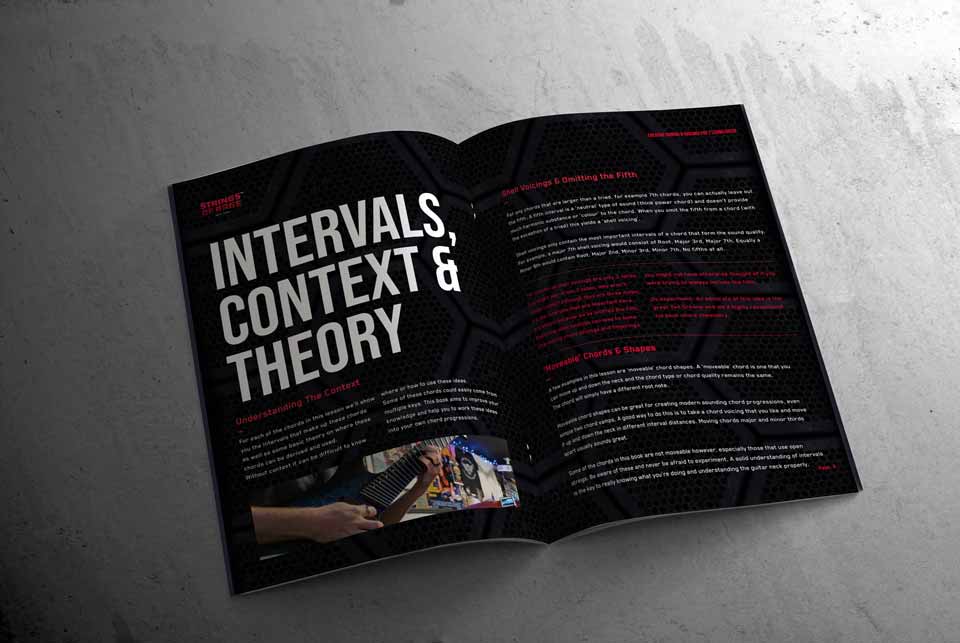
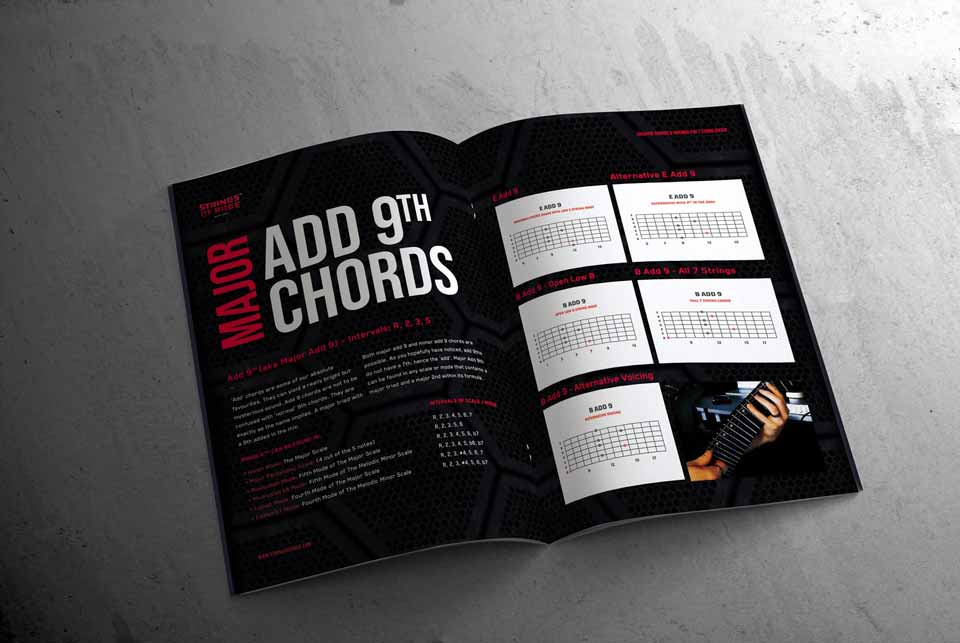
Continue Reading
In this lesson we’re going to break down the ultimate fretboard visualisation method. The interval system, also known as Intervallic Functions. You commonly see this fretboard visualisation method used by Jazz and Fusion guitarists such as Frank Gamble, Tom Quayle, Jack Gardiner, Guthrie Govan & Allan Holdsworth to name a few. All who are massive inspirations to us.
The Intervallic Function System, allows for true fretboard mastery. This goes way beyond 3nps scales, pentatonic box shapes, root position arpeggios and aims to prevent general noodling and instil intelligent note choices.
THIS is the system that will, beyond any doubt, take your playing and fretboard visualisation into the stratosphere if you’re willing to put in the work. Learning the intervals for guitar, or rather the intervallic function system, is vital to becoming a truly grounded musician. The learning hurdle for this method is quite a challenge but the payoff is greater than the hurdle is hard. In this lesson we’ll take a proper look at what it is and how to really understand and get to grips with this system that will enable true fretboard mastery regardless of what style of music you play. Being able to properly understand the fretboard applies to any genre of music.
Just like every modern player we’re always on the quest to expand our horizons. And what better way to do that than try to tackle the most freeing fretboard visualisation system of them all. This guide will help those players who have come to a plateau and are feeling stuck in a rut with 3nps scales and modes, just as we once were.
This is a very in-depth look at some vital guitar and music theory so brace yourself. Let’s do this!
Continue ReadingIn this lesson we’re going to breakdown this awesome melodic sweep picked arpeggio sequence by Iceferno. This creative sequence covers a few different chord tonalities, 7ths & inversions and ties them all together in one badass progression. Godspeed!
Here at Strings Of Rage we’re massive fans of the amazing songwriter Iceferno, who is also based in the UK. Like us Iceferno is also a huge fan of the Streets Of Rage series. We were super stoked to hear his interpretation of a Streets of Rage style album. His song ‘Vengeance II’ incorporates a sick melodic sweep picking progression that blew us away when we first heard it. This lesson is a great introduction to sweep picking arpeggios and sweep picking progressions.
Continue ReadingIn this lesson we’re going to look at how to use the Phrygian mode to create a metal rhythm part. We’ll look at how to play the mode on 6, 7 and 8 string guitars.
Continue ReadingBy popular demand of our Syndicate Members, in this lesson we’re going to be covering some really unorthodox, ways to play & map out pentatonic and blues scales. We’ll of course be covering these ideas on both 6 and 7 string guitars. If you’re observant you should be able to apply these to 8 string as well. Go Straight!
If you’ve been following us for a while now you’ll know we are massive fans of advanced pentatonic scales. Not just your typical box pentatonics, oh no, there’s nothing cool about single position 2nps pentatonic boxes. We’re all about progressing ideas on the instrument and discovering new ways to do things. So in this lesson we’ll be looking at unconventional uses of the pentatonic and blues scales. All these examples will use the minor pentatonic scale but if you understand the concepts you’ll be able to translate them to the major pentatonic too. Included in this guide is the dreaded three note per string pentatonics. Brace yourself.
We’ll be covering a ton of really cool ideas so get ready, you’ve never seen pentatonics like this before!
Continue ReadingGreetings! Today we’re going to look at some ways of writing lead melodies and leads over a riff made up of single notes rather than chords. We’ll assess each riff to work out which modes can be used. Included are 3 simple backing tracks. You can use these to improvise over and test out ideas. Let’s get started!
Continue ReadingWelcome to THE most in-depth lesson on the Japanese Hirajoshi Pentatonic Scale. Today we’re heading to the far east to unearth some inspiration. We’ll look to master this ancient sound firstly by learning the theory, intervals and shapes of this scale and then we’ll show you some killer ways to use it.
These Japanese style pentatonic scales are easy to learn because they feel so similar to the traditional pentatonics and dominant pentatonics. This scale will open up new ideas therefore imbuing your playing with an exotic new sound.
If you know your pentatonic scales then learning this Hirajoshi scale will be an exciting addition to your modal arsenal. Additionally if you know your Major Scale & Harmonic Minor Modes then you’ll find that Hirajoshi can be found within these scales as well. Use the Stage Select below to begin!
Continue ReadingToday we’re looking at a short arpeggio sequence that uses a 3 string minor 7 pattern. This arpeggio ascent works really well as a warmup. Let’s go over a few variations to help with our timing and coordination.
This Ascending minor 7 warm up is great because it gets all 4 fingers working in a way that isn’t chromatics. Further to this, beyond being just a warm up, this type of idea where we’re moving one arpeggio shape in different intervals is a great way to add ‘outside’ type flavours to your playing because it is essentially an unexpected key change.
Continue ReadingHigh A tuning? What is this mysterious extra high string you speak of? That’s not a proper 8 string guitar! An extra high string? We’ve heard it all. In this lesson we’re going to look at the Melodic Minor Modes using an alternative tuning for 8 string guitar. We’ll also touch on the Pentatonics of Melodic Minor and how to find them within each mode of this scale.
I have a fanned fret guitar with a 26 to 23 inch scale length so my guitar was specifically built for this tuning. While I like low F# 8 string music I’ve never been a fan of playing those guitars myself. For me, a low B or even drop A provides all the low end I could ever need, on top of this, I don’t have a really long scale length and fretboard to deal with.
Going one lower AND one HIGHER made much more sense. To me this unlocks many more possiblities than an additional low string. With a high A string we can now span 4 octaves in a single position, on top of this the chordal possiblities are amazing. Lets get into this lesson and check out the 8 string melodic minor modes.
Continue ReadingScary sounding stuff! As if diminished 7th arpeggios weren’t evil and twisted sounding enough for you, we’re going to combine them with chromatic runs using all 4 fingers. Inspired by Jeff Loomis, these types of insane diminished ideas will force you to re-think what is possible with diminished playing. All the examples in this lesson are based on F# Diminished 7th. Let’s Go!
Let’s start by looking at the different forms of Diminished 7th Arpeggios. Most of these ideas will use string groups D – G – B and G – B – E. Check out the diagrams below, this will make it more visual and make more sense. Part of the reason these ideas work so well is that we can ‘fill in the gaps’ in between the minor third interval from our index finger to our pinky on the highest string at the top of each arpeggio. This allows us to play a chromatic run really easily following the diminished arp. On top of this, because the diminished arpeggio inverts in minor thirds, we can blaze through these ideas all over the neck no problem at all by moving each shape a whole step and a half, aka minor thirds.
Continue ReadingToday we’re going to look at a quick warm up exercise. This one combines a descending sweep arpeggio with an ascending picking run. This is a great way to warmp up both hands.
Continue ReadingIn this lesson we’ll combine some tapping with a riff to create an unusual “alien” kind of sound. I’ll keep the riffs quite simple so that you can focus more on the tapping side. However once you get the hang of things you can start to combine these ideas with more complex riffs.
We’ll also look at doubling up on the tapping parts with a minor 2nd harmonised part. This will give it a dissonant and more alien sound.
Continue ReadingDominant 7th Arpeggios have many versatile hidden secrets that most players aren’t aware of. In this lesson we’re going to learn how to harness the true powers hidden within the dominant 7th arpeggio.
Most players who are familiar with music theory will associate the dominant 7th arpeggio with the mixolydian mode (mode number five) of the major scale. While this is true, it is just one of many ways in which we can derive this arpeggio. In this lesson we’re going to look at other scales and modes that contain this arpeggio as well as some modern triad pairings to create some super cool altered dominant sounds to add to your arsenal. Let’s Go!
Continue ReadingExtended Range Player? Let’s check out some killer ways to play Scales on your 8 String Guitar. In this lesson we’re going to check out some creative ways to diversify your scales, modes and arpeggios on your 8 string extended range guitars. The more ways you know your scales, modes and arpeggios the better you’ll be able to see the neck as a whole.
All these Scales for 8 String Guitar will be shown on an 8 string guitar neck with the assumed standard low F# 8 string tuning of F# B E A D G B E. Even though this is for 8 string, all you 6 & 7 stringers out there will also be able to take advantage of these concepts and ideas. We’ll start this level by looking at some extended major scale modes before getting into harmonic & melodic minor. For good measure we’ve even thrown in some standard and advanced pentatonics. Go Str-Eight!
Continue ReadingWelcome back! We’re going to look at a cool Arpeggio Sequence using B minor and A Major with some additional scale extensions. We’ll go over the shapes & positions, how to play it, and how to develop speed and accuracy.
We’ll throw in an inversion of Bm too for a bit of fun and extend the arpeggios to Bm(add11) and AMaj(add11). This arpeggio sequence is good for people who are new to sweeping. It will help you to get used to, and develop the technique. However its also fun to play really fast so if you’re already a good sweeper you may still enjoy this one!
Continue ReadingIn this episode we’re going to look at the Melodic minor scale and its Modes. We’re using standard 8 string tuning: F#, B, E, A, D, G, B, E. Each mode pattern will be 3 notes per string.
Like the Harmonic minor scale the Melodic minor scale is a based on the Aeolian mode. The Aeolian mode, or Natural minor scale is the 6th mode of the Major scale. By raising both the 6th and 7th notes of the minor scale we get Melodic minor. You may also see this scale referred to as Jazz Minor. Let’s take a look at Melodic minor for 8 string guitar:
Continue ReadingWelcome guitar fans, to yet another in depth scale study & theory lesson. This time we’re looking at the mysterious Pentatonics of Melodic Minor. The Major b6 Pentatonic & The Minor b5 Pentatonic.
These are scales that most players don’t know but will add a new arsenal of exotic possibility to your playing if you can nail them down. This lesson goes deep, so warm up, plug in, & get ready!
The basic format for the pentatonics of melodic minor are still two note per string, however the fingerings and intervals will feel unconventional if you’re used to the standard major and minor pentatonics. We’re going to look at these scales on a 7 string guitar however if you don’t have a 7 string, don’t worry! You can still learn these shapes but your root notes will change.
Continue ReadingIn this lesson we’re going to look at Harmonic minor for 8 string guitar and its Modes. We’re using standard tuning: F#, B, E, A, D, G, B, E. Each mode pattern will be 3 notes per string.
Before looking at Harmonic minor for 8 string, first we need to understand the difference between the Natural minor Scale and the Harmonic minor Scale. Natural minor, or just minor, is the 6th mode of the Major scale, also called the Aeolian Mode. In order to get the Harmonic minor scale we need to raise the pitch of the 7th note by a semi-tone.
Continue ReadingWelcome back extended range players! In this episode we’re checking out the three-note-per-string melodic minor modes for 7 string guitar, tuning BEADGBE. We’ll also outline some theory for the melodic minor modes so you’ve got basic understanding of their application.
In metal, melodic minor and its modes are widely disregarded and rarely considered for songwriting, however it can yield some amazing dissonant results and open up entirely new ideas. Even more creative ideas can be unleashed if you combine these with the intervallic Pentatonics of Melodic Minor. Let’s check out the Melodic Minor Modes for 7 string so we can add them to our modal arsenal!
Continue ReadingWelcome to Power Up! episode 4. This time we’re looking at Sweep Picking. We’ll be focusing on a 3 string, major chord triad. The idea here is to focus on one shape to help really develop the sweep picking technique without making things too complex.
Continue ReadingWelcome back to another scale study lesson! In this lesson we’re going to check out the 5 positions of the pentatonic scale and how they translate to the 7 string guitar! We’ll also look at some extended concepts for advanced pentatonic application. All these examples can be applied to 6 string as well but more players are looking to the extended range guitars to take their playing to the next level and expand their knowledge.
In this lesson we’ll not only learn the 5 positions of the Pentatonics for 7 String Guitar. We’ll also learn how they reference the corresponding modes of the major scale. If you have the ability to mix your pentatonic and modal playing this will massively help you visualise the neck. This will also help you create interesting melodies and new creative ideas. We’ll also include some advanced concepts that will help you break out of the standard ways of playing pentatonics.
Continue ReadingIn this lesson we’ll be looking at a couple of quick warmup exercises that uses all 4 fingers. We’ll start with a chromatic pattern and then look at a couple of variations. 4 finger patterns are a perfect way to get warmed up as well as become more accustom to using all 4 fingers more efficiently.
The aim with this guitar warmup exercise is to warmup your picking hand and fretboard hand & fingers. Once warmed up you can start to practice more complex ideas with less risk of strain or injury. When using alternate picking make sure that both hands are really in sync with each other. If you’re used to picking in a 3nps fashion then this will really be a test of your dexterity.
Continue ReadingWelcome to episode 3 of Power Up! This time we’ll be looking at a simple picking lick. The idea is to repeat this slowly over and over to develop coordination between your fretboard hand and your picking hand.
Developing coordination with this odd time alternate picking idea across all 4 fingers on your fretboard hand will help not only with picking ideas like this but also many other aspects of your playing, from advanced chords to riffs and of course shred techniques.
Continue ReadingWe’re Levelling Up! In this advanced multi finger tapping lesson we’ll break down a Phrygian Dominant tapping lick that switches between a 5 and 6 finger pattern across two strings. We’ve written a short piece of music for this solo which you can download as a backing track to practice these ideas. Player 1 Press Start!
There’s some cool ideas packed into this multi finger tapping lesson so lets get into it! This 5 & 6 finger tapping T2 T3 tapping idea using the three octave Phrygian Dominant mode. For reference; Phrygian Dominant is mode #5 of its parent scale which is Harmonic Minor. Using and adapting three octave scales makes licks really easy since they simply repeat across the neck in big octave jumps every two strings. This also means you can cover a large part of the neck really quickly.
Continue ReadingToday we’re going to look at some arpeggios for seven string guitar. In this episode we’ll learn some of the basic triads across 7 strings and then in future episodes we will expand on these to form more complex chord arpeggios.
If you’re an extended range player you’re probably already curious as to how to expand your ability to include the 7th string. These 7 String Sweep Picking ideas will definitely test your playing and finger dexterity. Always remember to take these ideas slow at first, speed is always a by-product of control! Lets go!
Continue ReadingWelcome! In this Strings of Rage™ webisode we’re going to look at a unique way to blaze through multiple octaves across the neck. This is a great way to cover a lot of the neck quickly and creatively. This works out great not only as a rippin’ shred lick but you can weave these types of exotic dominant sounding ideas into your lead melodies as well.
To do these Dominant Sweep Picking Arpeggios we’re going to use the dominant pentatonic scale as our basis. With a bit of creative thinking we can lay out this scale in a way that lends itself to an ultra efficient & seamless sweep picking pattern. Let’s get to it!
Continue ReadingWelcome! In this lesson we’re going to learn a creative string skipping and tapping sequence that changes key on the same root note, meaning that we’ll change between G Major & G Minor. We’ll also be using some extended arpeggios that use 7th and 9th extensions.
We’re going to take two basic string skipping tapped arpeggios and make a sequence out of them to make it more interesting. This tapping sequence uses T2 and T3 tapping, that’s two fingers on your picking hand. Usually I would suggest your middle and ring finger so you can still hold the pick. For a really creative sound that throws your listener off we’re going to change key using the same root note. Let take a look at these basic shapes first and then we can check out the sequence.
Continue ReadingIn this episode of Power Up! we’re going to look at a simple tapping lick in B minor. This will help you to perfect the technique before moving on to more complex tapping ideas.
Tapping in B Minor – We’re going to tap with both hands rather than pulling off from the picking hand to the fret-board hand, although feel free to play it that way too. This will give us a slight “staccato” feel. Check out the video below:
Continue ReadingWriting (not Falling) In Reverse! In this lesson we’re going to look at some ways to add rhythms to a lead guitar part when the lead part was written first. We’ll use a lick that we’ve previously written in B phrygian to demonstrate and find inspiration to how this can work.
Most commonly you would write a rhythm track and song structure before exploring how melodies and solos can work over the given chords. Understanding how to reverse engineer these ideas will not only help writing a guitar solo, but it will help your guitar playing in many other ways too. If you can master this you’ll be a versatile band musician as well. If you’re anything like us you’ll always find times where you’ve written an incredible lead lick, solo or melody that then needs backing music to support it! Let’s get into it!
Continue ReadingWe’re back for another deep dive into some exotic sounds, this time through the mystical Neapolitan Minor Scale! If you’re looking to unleash some exotic flavours into your playing then check this out! We’ll be learning all the modes of this scale as well as the chord qualities that can be derived from each mode. Let’s get into it!
The Neapolitan minor scale is a really exciting one, you could think of it as harmonic minor with added chromaticism. Used in the right way, this scale and its related modes can really throw your listener off with dramatic effect! We’ll be sure to check out the modes of this scale as well as the corresponding chords that are available.
Continue ReadingIn this episode we’re going to take a detailed look at intervals, what they are and the sound quality of each interval type. An understanding of intervals is absolutely essential to avoid the guesswork when navigating the guitar neck not just with lead lines but creative chord voicings too.
Let’s understand the intervals for guitar. The most underestimated weapon in your arsenal of musical weaponry. Essentially intervals are simply the distance between notes, however with a little understanding you can harness the true power of intervals to achieve any sound you want. We’ll also learn about interval note quality and how this can help unlock songwriting creativity.
